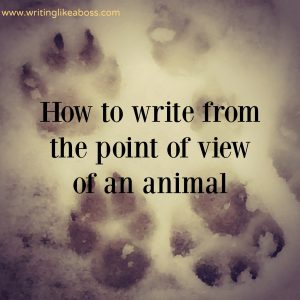 Writing about people (and the such) is generally the common POV authors work from. And of course they do; it’s easier to relate to a person than a bobcat. But for the younger age group, sometimes they’ll be more likely to pick up a book with an heroic young dog on the cover (I know those things attracted me when I was younger).
Writing about people (and the such) is generally the common POV authors work from. And of course they do; it’s easier to relate to a person than a bobcat. But for the younger age group, sometimes they’ll be more likely to pick up a book with an heroic young dog on the cover (I know those things attracted me when I was younger).
Writing from an animal’s POV can’t be too hard, right? I thought so at first. It may seem easy, but there are a few things you need to keep in mind.
- RESEARCH YOUR ANIMAL
Some of my favorite animals are snow leopards and seahorses. Do I know anything about their territorial habits, their instincts, the climates they tend to live in? Nope. I chose wolves instead, because I’ve been studying canines for years now. Before you even begin your outline, research your animal. Wikipedia is a good source, I’ve learned. Or you could go old fashioned and purchase (or borrow ) a book on that animal. Just make sure you have all the info you need before you begin writing. - USE YOUR RESEARCH
When doing your research (as mentioned above), take notes of the most important things. (Or leave notes in the margins of a book and mark the page.) When you actually begin writing that first draft, read over your notes constantly. Include your animal’s instincts, their habits, their food preferences. BUT WAIT, there’s a catch. - LIMITS
There are limits to writing the instincts and natural tendencies, especially if you’re writing fiction. Every animal has his own personality, his own quirks – just like people. If you’ve had pets in the past, you should know that some animals can be mischievous little rascals that get into trouble constantly, and others that just want to curl up in a nice corner and sleep. Give each of your animal characters deep personalities, just like you would for a person.
If you really want your writing to pop, have the animals occasionally go against their instincts. Not too often, but just often enough for the readers to notice if they look closely. - BE CONSCIOUS
If you’ve read my books, The Undiscovered Tribe, you’d know that my wolf characters seem a very human-like. And that’s just my writing style. Be conscious that, to animals, having four legs and thick fur is normal. Don’t bring up their descriptions too often, because that’ll make it seem as if these things are odd or different. Even if you’re writing about unicorns or dragons, don’t exaggerate the oddness of something unless your protagonist genuinely finds it a bit off. Seeing her gryphon brother in the morning is nothing different, nothing new (even if he IS a gryphon!).
